Over the holiday break, I took a trip to Southern California to see loved ones and soak up the best weather in the U.S. Of course when you write about an industry as prevalent as plastics, it's hard not to think about work while on vacation.While on the Malibu beach, I was first struck by how just clean the beach was. Since I've primarily lived in landlocked states, my only impression of beaches in the U.S. was that of crowds and trash littering the sand.
January 3, 2014
Over the holiday break, I took a trip to Southern California to see loved ones and soak up the best weather in the U.S. Of course when you write about an industry as prevalent as plastics, it's hard not to think about work while on vacation.
While on the Malibu beach, I was first struck by how just clean the beach was. Since I've primarily lived in landlocked states, my only impression of beaches in the U.S. was that of crowds and trash littering the sand.
 But the Malibu beach was far from that. It was quiet and I didn't see any type of trash. But then my eyes fell upon a familiar logo on a recycle bin - the American Chemistry Council. I then noticed all the recycle bins located throughout the beach, each barring the words, "Keep our Beaches Clean," and "Plastics. Too Valuable To Waste. Recycle."
But the Malibu beach was far from that. It was quiet and I didn't see any type of trash. But then my eyes fell upon a familiar logo on a recycle bin - the American Chemistry Council. I then noticed all the recycle bins located throughout the beach, each barring the words, "Keep our Beaches Clean," and "Plastics. Too Valuable To Waste. Recycle."
Since 2009, the plastics industries of the American Chemistry Council has partnered with Keep California Beautiful, the California Department of Parks and Recreation (California State Parks) and the California Department of Transportation (Caltrans) to put more recycle bins on beaches, campgrounds, and rest areas. Since the program began, the group has installed nearly 700 recycling bins and educational signage in 19 communities along the California coast.
I was glad to see this initiative appear to work, at least on the Malibu beach. I visited other beaches in the San Diego area and did spot pieces of plastic packaging ever so often on the sand. And guess what was missing? The recycling bins.
Let's face it, leftover packaging is quite prevalent on many beaches. In fact, the United Nations estimates that at least 7 million tons of trash ends up in the oceans every year, of which 5.6 million tons are plastics. Most of the time, the biggest issue is a lack of accessibility to recycle the items.
I hope other California beaches add recycling bins. That state and its beaches are just too darn beautiful to litter with any type of waste.
Bag bans are real
Sometimes I wonder if readers get tired of stories about plastic bag bans. But then I looked at the PlasticsToday site stats for 2013 and saw that some of the most read stories were about bag bans. Clearly, this is an important issue to the industry.
While I've written about the subject several times, I've never experienced what it's like to shop at a grocery store where plastic bags are banned - until I went to one in Orange County. After I picked up some necessary items, such as energy bars and bottled water, I went to the counter to pay. The attendant asked how many bags I thought I would need for my items. Unsure, I said two. The attendant rang up two paper bags - which cost 10 cents each. However, as she packed my items, she noticed that I actually only needed one. But since I had paid for two bags, she tried to spread out the items among the two to the best of her ability.
And that was it. So it appears, as a consumer, the biggest obstacle with having to pay for bags is to gauge how many bags you need. While 10 cents is not breaking the bank, it can add up quickly if you purchase lots of items at the store on a daily basis. Clearly, the other solution is to bring reusable bags, which does present constant debate about its sanitation.
I have to say, it did feel a bit weird having to pay for a bag. But I know in some places that is the new normal and they just learn to deal with it, because they have no other choice.
About the Author(s)
You May Also Like


